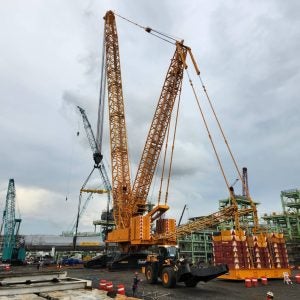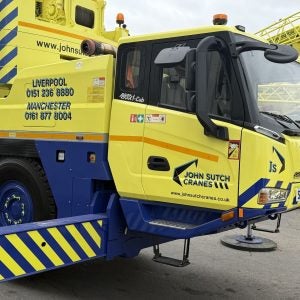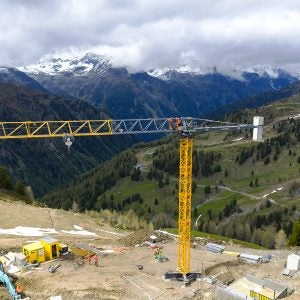Highlights of CICA president John Gillespie’s annual report included:
• A 24 per cent growth in cranes assessed under the CraneSafe programme, compared to the previous year (CraneSafe has now become a separate CICA business unit with a three-person management committee, and will expand into tower cranes and vehicle loading cranes)
• Funds from CraneSafe have been used to develop training around a crane simulator and a CD-ROM training course on Setting up of Cranes
• Industry concerns raised in a presentation to the National Transport Commission included national uniformity, gaining a 12 tonnes per axle allowance for all terrain cranes, allowing 16.00 tyres on some cranes, gaining an additional two tonnes allowance for truck cranes and delays in obtaining travel permits.
• The CICA constitution is being revised.
A regular feature of the conference is a panel of representatives of the major manufacturers answering questions on world crane developments. Those in the spotlight at the 2006 conference were Hans-Georg Frey (managing director of Liebherr-Werk Ehingen), Thomas Schramm (director of sales for Terex Demag) and Eric Etchard (executive vice-president of the Asia region for Manitowoc Crane Group). In brief, their responses indicated:
• Manufacturers will not be rushing to use Weldox 1300 steel but are investigating its future use
• Tyre availability will affect all terrain crane production through 2007 but the situation should improve in 2008
• The rapid model changes are not depressing crane values. The pace of change is dictated by customer feedback and supply and demand dictate used crane prices, which are currently quite high
• Despite a recent period of rapid advances in technology, no manufacturer believes that this period is reaching an end. Pressures will continue for more compact cranes of greater capacity and boom length, and advances will be made in materials and electronics.
• No immediate respite is seen for the current long time leads for crane delivery. Manufacturers have ramped up production capacity, but are limited by the capacity of suppliers, and the need to maintain quality and industrial safety (70 per cent of industrial accidents occur to people with less than 12 months of experience)
• Manufacturers are moving towards greater use of disc brakes, and these will appear in all new Liebherr models.
• China is not seen as a viable source of all terrain cranes in the immediate future.
• Manufacturers would like to see the three-year cycle of major trade shows cover the major regions of the world in rotation, with Bauma, Conexpo and a single Chinese exhibition being the preference.
Some presentations indicated that progress was being made with a GPS-based Intelligent Access Protocol that could see more flexible road access for cranes in Australia, but given that this has been promised but not delivered previously, some sectors of the industry are understandably cautious in their exuberance.
Despite the island location, there was a substantial display of mobile cranes barged from the mainland, with the largest being a 220-tonne Liebherr brought from Townsville for the conference. Amongst the other cranes on display were the first of the current generation Tadano Faun all terrain cranes in Australia, a Grove carry deck crane and a Dieci telescopic handler fitted with a crane jib.

Eagle Cranes and Rigging won the Major Lift of the Year for its project of replacing a 110-tonne kiln tyre (3.5 metres long and 4.5 metres in diameter) at the Queensland Alumina Ltd plant in Gladstone for ThyssenKrupp Engineering (Australia). The kiln tyre had to be installed directly under a duct that could not be removed, and there was only six metres of headroom.
The lift was further complicated by a shutdown happening at the plant at the same time, restricting the space available to set up cranes as an access way had to be kept open. A self-propelled modular transporter (SPMT) carried the new kiln tyre to the lift site in the vertical position, because of head height restrictions. It was initially lifted off the SPMT using a 100-tonne Liebherr LTM1100 mobile crane and a 280-tonne Liebherr LR1280 crawler crane, and then rotated into the horizontal position and placed in a stand the day before being installed, to reduce the number of operations required for the main lift. A second stand was fabricated to receive the old kiln tyre in the horizontal position.
Lifting lugs were welded onto the old kiln tyre, along with a deflection bar on one side. The LR1280 hooked onto the main lugs while a 220-tonne LTM1220 mobile crane hooked on under the deflection bar. One crane jibbed up while the other jibbed down, effectively rolling the kiln tyre out from under the duct so that it could be slewed and lowered onto a stand before rotation and removal by the SPMT.
A reverse of this procedure saw the new kiln tyre rolled into position. The lift lugs were welded at an angle to allow for the required 300 mm fall in the installed position. The main lift commenced at 5.00 am and was completed by 10.30 am.

First time entrant Williamstown Crane Hire won the Simple Lift category for the installation of the 25-tonne, 28.5-metre long Aqualung sculpture on Captains Walk between the twin towers to the National Australia Bank building in Melbourne’s Docklands precinct.
The sculpture had to be turned through 90 degrees, lifted to clear steps from street level up to walk level, and then moved under an overhead walkway to the final resting position. The main lifting equipment was two Grove cranes, a 200-tonne GMK5200 and a 100-tonne GMK5100. As the walkway was above an underground carpark, there were strict limits on how much load could be placed on the walkway and where that weight could be placed.
James Contracting Services built a special lifting cage for the sculpture, as well as a transport trailer. The frame was lifted from its trailer and rotated until one end could be placed on a special steerable skate at the top of the stairs. The GMK5200 then released that end and hooked on to the opposite end, so that the GMK5100 could be unhooked. A 25-tonne Franna MAC25 crane hooked on to the end of the frame to act as a brake while the GMK5200 boomed out to push the frame under the overhead walkway, until the rear of the frame could be placed on skates. The frame was then pushed into position, the sculpture was jacked down onto foundations and the frame was dismantled from around the sculpture.
The Crane Industry Association of Queensland hosted the conference, and retiring Queensland association president Graham Snow and his wife Debbie worked tirelessly in organising the conference as their last activity in the industry following the sale of their business.
Hugh Morris received the industry service award, recognising his service as president of the Victorian Crane Association from 1994 to 2000, his ongoing service as a Victorian representative on CICA, and his service on committees of both associations. As a crane fleet owner, he was a pioneer in the use of large cranes in precast erection.






